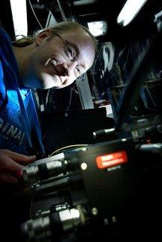Spectral control of diode lasers using external waveguide circuits
Promotion date: February 1.
Promotor: Prof.dr. Klaus Boller
Assistant Promotor: Dr.ir. Herman Offerhaus
| Spectral control of diode lasers using external waveguide circuits is investigated. Such external control can provide a new class of diode lasers with technologically interesting properties, such as a narrow spectral bandwidths and spectrally tunable output in a hybrid integrated format. Micro-ring resonators reflect and filter emitted light, causing the diode laser to have narrow bandwidth and a widely tunable output, over 40 nm, making them interesting for a variety of scientific and industrial applications. Additionally, the possibility of simultaneously controlling the spectrum and phase of entire arrays of diode lasers is investigated. The superimposed output may offer the generation of trains of ultrashort pulses. Because this new method uses multiple separate gain media, it is therefore called separate gain (SEGA) mode locking. Such sources can, for example, be of interest for high-speed optical data storage. |
Was your work of an experimental nature?
The concept of using multiple diode lasers for mode locking in a separate gain setting is new, so a lot of exploratory experiments have to be carried out in various different aspects. The simultaneous control of frequency and phase is crucial in this approach, to actively control the constructive and deconstructive interference of multiple longitudinal modes. Our calculations show the newly developed method should be able to work and could contribute to the first combination of very high optical powers combined with extremely high repetition rates, for example of use in novel data storage in upcoming generations of computer technologies.
Though I like working on experiments more, theory was an equally important part of my thesis work. I guess it was divided in a fifty/fifty ratio. Detailed calculations on the position of the diode laser emitters for example, resulted in a theoretical confirmation of the possible feasibility. This contributed to the design of clever experiments leading to some initial results. So, theory and experimental work reinforce one another.
I had a steady progress during the period of research, working simultaneously on the different laser techniques. When we finally saw indications of the results we were looking for, there was a moment of relief, not lasting very long though. After this we had to reassure our findings, which showed we saw mostly measurement artefacts. This is an evenly challenging stage of research; no result is also a result.
Were your findings published?
I had a total of two peer-review publications: one in Optics Express and one in Laser Physics Letters. There are two publications still under construction at this moment.
In what way did the PhD work contribute to your research skills and your personal development as a scientist?
Nowadays I am much less frightened by theoretical and numerical aspects of the job. These activities are necessary to understand the relevant processes taking place in one’s research field. As an experimentalist I am much more skilled now as a result of the many hours I spent in the lab.
What are your future plans?
In the near future I will be working for a spin-off company of the University of Twente, Satrax. The company aims on commercializing a radical new system of satellite tracking. The product is on its way from academics to the application world. I will be working on designing and laboratory work, and also some managing tasks will come into focus. The main challenge will be the miniaturization of all components involved in this new and complex microwave photonics device.
What, in your opinion, is important for Mesa+ to stay successful in future?
The collaboration with spin off companies like Lionix and XiO Photonics, I appreciated greatly. We could make use of their cleanroom, but more importantly I gained a lot of expertise knowledge from them as an experienced producer of complex nanoproducts and components. Coupling the diode lasers in a practical way would be impossible without them.
In a broader sense, I believe for PhD’s and researchers, it is important to find a good balance between cost effective experiments designed and the freedom to repeat experimental setups when necessary. Sometimes a little step back is necessary to make sure further progress is possible. It is better being able to perform five experiments in a row than just being able to carry out one crucial experiment.

